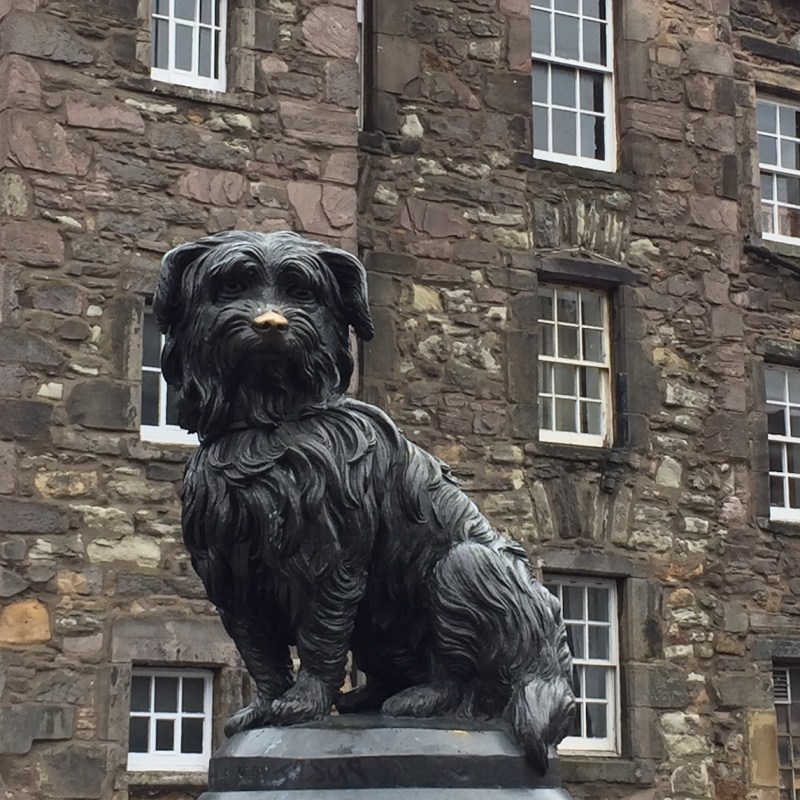
You probably know about the Loch Ness Monster, but have you ever heard of kelpies or wulvers?
Videos by TravelAwaits
Scots are legendary storytellers (they even host an International Storytelling Festival), and their culture is rich with imaginary creatures — or, perhaps, creatures not so imaginary… Here are some of my favorites.

1. Unicorns
No list of Scottish mythical creatures would be complete without mentioning Scotland’s national animal — the infamous unicorn, which adorns the country’s royal coat of arms. In Celtic mythology, the unicorn represents both purity and power, innocence and dominance. The creature has been part of Scotland’s ethos for centuries.
According to legend, the unicorn is fiercely independent, is the strongest of all wild animals, and can only be tamed by a virgin maiden. No wonder independent Scots have incorporated this creature into their national character!
No one knows how the unicorn myth got started, but some have speculated that an ancestor of the rhino, the now-extinct Siberian unicorn, which lived alongside humans 35,000 years ago, may be the prototype. Others point toward the “unicorn of the sea,” the narwhal.
But it was William I who introduced the unicorn to the Scottish royal coat of arms in the 13th century. Upon unification with England in 1603, James VI of Scotland (who became James I of England) replaced one of the unicorns in the crest with a lion, England’s national animal, to symbolize the joining of the two nations.
Pro Tip: Unicorns are ubiquitous in Scotland! The Palace of Holyroodhouse, Edinburgh Castle, Craigmillar Castle, and St Giles’ Cathedral — all in Edinburgh — sport unicorns. But, really, anywhere you go in Scotland, you can find a unicorn. Consider visiting on National Unicorn Day (celebrated on April 9) to get your unicorn fix.

2. Kelpies
The flip side of the endearing unicorns are the terrifying kelpies, shape-shifting horses that live in rivers and streams and drag unsuspecting victims to their death.
According to legend, a kelpie may appear as a tame horse to entice a child or as a beautiful woman to lure a young man to touch its sticky hide. Once a victim is stuck and trapped, the kelpie will drag it underwater to eat it. Or a kelpie might engage its magical powers to create a great flood to sweep its victim into its clutches.
The sound of a kelpie’s tail entering the water is said to sound like thunder. Be especially careful walking along rivers or streams just before a storm, when kelpies’ haunting wails offer an ominous warning.
Although the origin of the kelpie myth is elusive, it has endured. Scottish poet Robert Burns memorialized the beasts in his 1785 poem Address To The Deil (or “Devil”): “Then water-kelpies haunt the foord, / By your direction, / And ’nighted trav’llers are allur’d / To their destruction.”
Pro Tip: Visit the world’s largest equine sculpture — two magnificent horse heads (kelpies!) in Falkirk’s Helix Park. It’s possible to take a guided tour of The Kelpies and even go inside the 98-foot statue.

3. Loch Ness Monster
The Loch Ness Monster may, in fact, be a kelpie. The earliest mention of the infamous sea dinosaur dates to the sixth century, when Saint Columba, an Irish monk, was told that a “water beast” had dragged a local man underwater, drowning him. Saint Columba enlisted one of his followers to swim across the river to lure Nessie ashore. But halfway across, the sea serpent attacked the man. According to onlookers, Saint Columba made the sign of the cross and shouted, “Go no farther. Do not touch the man. Go back at once.” The creature made a hasty retreat.
But the legend took off in the 1930s, sparked by a part-time journalist for the Inverness Courier who wrote about the possibility of a sea serpent in the lake’s waters. Three months later, a couple reported seeing a prehistoric dragon-like creature waddling across the road to the loch. After the Courier ran that story, more reports of sightings surfaced, and tourists flocked to the loch to be the first to snap evidence of Nessie.
That evidence was provided by Hugh Gray in December of 1933 — a photograph, which prompted the Scottish government to pass legislation to protect the Loch Ness Monster from harm. Thirty years later, the original negatives proved the “monster” was an otter rolling on the surface.
Then came the definitive “surgeon’s photograph” published by the Daily Mail in 1934 — which was, years later, determined to be a hoax concocted by a disgruntled employee of the newspaper.
Over the ensuing decades, research teams have filmed, taken sonar readings, and studied old photographs in search of the infamous Loch Ness Monster, usually finding proof just inconclusive enough to keep the mystery alive.
Pro Tip: Modern-day Nessie hunters can search Loch Ness underwater or overwater on Google Street View.
4. Wulvers
Wulvers are humans with wolf heads whose bodies are entirely covered in hair. Ancient Celts believed them to be the evolutionary stage between wolves and humans.
Stories of these benign creatures originated in the Shetland Islands but have since spread across Scotland. They’re solitary creatures who live in caves near the shore, survive on fish, and are said to leave fresh fish on the windowsills of poor families. They are also known for guiding lost travelers to nearby villages.
The last reported sighting of a Wulver was in the early 1900s in a cave in the Shetlands. Modern folklorists theorize that the myth may have stemmed from a local family living with a genetic disorder called hypertrichosis — a condition in which hair grows over the whole body.
Pro Tip: It’s a long shot to see these solitary, elusive creatures, but they are known to fish from rocks called wulver’s stanes (“wolf stones”) in the Shetland Islands.
5. Selkies
Selkie fowk (“seal folk”) are seals that come ashore, shed their skins, and become strikingly handsome human forms in order to lure lonely fishermen’s wives or wayward men into affairs. Then they slip back into their seal skins and rejoin their watery kin.
The myth may have originated with fur-coated explorers who seduced the locals. Children born with webbed digits or scaly skin were considered the offspring of human-selkie liaisons. Others theorized that selkies were reincarnations of people lost at sea, or fallen angels trapped in seal skins.
In Tales of the Seal People: Scottish Folk Tales, Duncan Williamson suggests that the myth arose to pacify children whose relatives were lost at sea: “They probably joined the seal people, became seal folk. And you’ll see them again.”
Whatever the origins are, many variations of the tale persist — often with a selkie’s seal skin being stolen by the human who has fallen in love, forcing the selkie into a human life. Usually, the selkie finds their skin and resumes life at sea — and can’t return to land until seven years have passed.
Pro Tip: Since selkies only make themselves known to their intended lovers, the easiest place to find them is in modern literature and movies, such as The Secret of Roan Inish, directed by John Sayles; John Gray’s The Seventh Stream; or Neil Jordan’s Ondine.

6. Greyfriars Bobby
One of Edinburgh’s most endearing and enduring myths is of Bobby, the lonely dog who held vigil at his master’s grave in Greyfriars Cemetery. But in 2011, a social historian from Cardiff University, Dr. Jan Bondeson, blew the cover on the story. Bobby wasn’t the beloved pet of policeman John Grey, who died of tuberculosis in 1858. According to Dr. Bondeson’s research, he was a stray kept well fed by the locals.
In examining old photos and paintings of “Bobby,” Bondeson discovered that the dog’s appearance radically changed in 1867.
“The first Bobby was quite an ugly dog, but in later paintings he looks just like the statue on the drinking fountain,” Bondeson told BBC News in 2011, referring to the bronze statue of a Skye terrier erected above a drinking fountain just outside the graveyard.
Apparently, by the time the original stray died, “Bobby” had become such a lucrative tourist draw that the locals adopted another dog — the more photogenic Skye terrier — to keep the myth going another five years.
The curator of the graveyard, James Brown, would impart the woeful tale of the loyal dog to tourists — for a tip, of course — before directing them to lunch at a friend’s nearby restaurant. Minutes from meetings of the Edinburgh City Council revealed that the councilors knew about the hoax!
Pro Tip: To learn more about the various versions of Bobby’s illustrative history, take a tour with Paul (last name withheld), a formerly homeless man who now takes visitors — both in person and virtually — through Edinburgh. “It is my job to seek out the truth behind the myths and legends,” wrote Paul, who was trained by the nonprofit Invisible Cities. “This is how I discovered that the Greyfriars Bobby story has an alternate version.”
7. Haggis Birds
Most visitors to Scotland know — or learn very quickly! — that haggis is a beloved national dish. It’s a sausage-like concoction of sheep offal (minced heart, liver, and lungs) often served with neeps and tatties (mashed turnip and mashed potatoes).
But not many visitors have prior knowledge of the equally beloved haggis bird, said to be the actual source of traditional haggis. It’s not really a bird, but more of a four-legged rodent-like creature with a long silky mane. If their left legs are shorter than their right, the wild haggs and hagglets graze counterclockwise up Scotland’s heathered hillsides. But if their right legs are shorter than their left, the “birds” graze clockwise up the hills.
While tales of spotting the elusive wild haggis birds have been passed down through generations, the first written report of a haggis hunt was published in 1924 in the New York Tribune. The myth is so persuasive that a 2003 study found that one-third of American tourists to Scotland believe wild haggs exist, and 23 percent come to Scotland hoping they can catch one.
Pro Tip: Hunt down your own haggis bird in the Kelvingrove Art Gallery and Museum in Glasgow, which showcases a stuffed Haggis scoticus. Gotta love those leg-pulling Scots!
